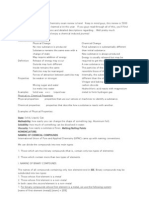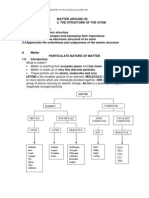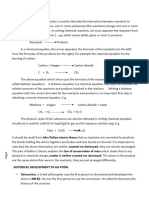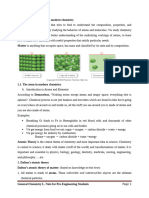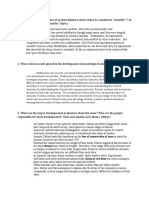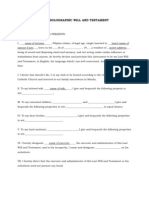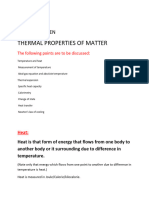Energy Transformations Science Review: When Studying For This Portion of The Test, Be Sure To Review The Following
Energy Transformations Science Review: When Studying For This Portion of The Test, Be Sure To Review The Following
Uploaded by
sherryjasminCopyright:
Available Formats
Energy Transformations Science Review: When Studying For This Portion of The Test, Be Sure To Review The Following
Energy Transformations Science Review: When Studying For This Portion of The Test, Be Sure To Review The Following
Uploaded by
sherryjasminOriginal Description:
Original Title
Copyright
Available Formats
Share this document
Did you find this document useful?
Is this content inappropriate?
Copyright:
Available Formats
Energy Transformations Science Review: When Studying For This Portion of The Test, Be Sure To Review The Following
Energy Transformations Science Review: When Studying For This Portion of The Test, Be Sure To Review The Following
Uploaded by
sherryjasminCopyright:
Available Formats
ENERGY TRANSFORMATIONS Science Review
When studying for this portion of the test, be sure to review the following: 1. Understand radioactivity and describe the half-lives of elements 2. Examine the phases of matter and the related atomic and molecular motion 3. Analyze energy transformations and the flow of energy in systems a. Understand molecular motion involved in thermal energy changes due to conduction, convection, and radiation. Assessment will focus on the following: 1. Describing the process of radioactive decay in which the unstable nucleus of a radioactive isotope spontaneously decays. 2. Calculating the amount of a radioactive substance that will remain after one half-life. 3. Analyzing graphs, tables, and other displays of data to determine the length of half-life or the amount of materials remaining after one half-life. 4. Understanding that as temperature increases, the motion of molecules increases. 5. Describing a solid as a composition of particles closely situated in position giving a definite shape and definite volume and that little motion occurs between particles as compared to other phases of matter. 6. Describing a liquid as a composition of particles free to move, giving a definite volume but not a definite shape and that particles have a greater range of motion as compared to solids. 7. Describing gases as a composition of particles that move more that particles of either a solid or a liquid, giving no definite volume or shape, and colliding more randomly than particles of solids or liquids. 8. Understanding that a phase change requires a gain or loss in energy. 9. Describing the two forms of energy encountered during a single energy transformation, including chemical, heat, light, electrical, and mechanical. 10. Identifying the processes of conduction, convection, and radiation that occur during thermal energy changes. Become Familiar with the following terms: Alpha radiation Beta radiation Gamma radiation Half-life Solid Liquid Gas Phase change Melting Freezing Sublimation Vaporization Condensation Conduction Convection Radiation
Lakeside High School Science Department
RADIOACTIVITY AND HALF-LIFE
HALF-LIFE Each radioactive element breaks down after a certain amount of time to become stable. This time is measured in half-life. A half-life is the time required for one half of the substances atoms to break down and become stable. The half-life for a substance does not change. Some examples are carbon-14 (half-life of 5730 years) and uranium-238 (half-life of 4.5 billion years). When asked to work a half-life problem, draw the boxes, like the ones below, to help you answer the question.
All atoms are radioactive
One half-life later, half are radioactive
Two half-lives later, are radioactive
Three half-lives later, 1/8 are radioactive
RADIATION The unstable elements tend to break down spontaneously. They do not have enough binding energy in their nuclei to hold the protons and neutrons together. Most radioactive nuclei have too many neutrons compared to their protons. These elements are said to be radioactive. Radioactivity is where rays are spontaneously produced by the nucleus of an unstable atom. It can be particles, energy, or a mixture of both. Types of Radioactive Decay: Alpha Particle, : Has a +2 charge; the particle is composed of two protons and two neutrons; Is stopped by skin, tissue paper. These particles are not very energetic. The atomic number drops by two. It is sometimes written as a helium atom: He Example: When uranium (atomic number 92) undergoes radioactive decay, it gives off an alpha particle. The atomic number drops by two and it becomes the element, thorium, with an atomic number of 90. Beta Particle, : Has a 1 charge; comes from a neutron being given off the neutron gives off a beta particle (negative) and a proton (positive); the beta particle leaves and the proton stays in the nucleus. Metal foil stops this particle. The atomic number increases by one. Example: When bismuth (atomic number 83) undergoes radioactive decay, it gives off a beta particle. The atomic number increases by one and it becomes the element polonium, with an atomic number of 84. - Gamma Ray, : Has no mass or charge because it is energy. It is high-powered electromagnetic radiation and it is stopped by lead, concrete. Uses of Radioactivity - Medicine: Radiation is used as a form of therapy for cancer. X-rays and gamma rays produced by cobalt-60 or cesium-137. Radioactive elements can be used as tracers that can follow certain chemical reactions inside living organisms. - Industry: Food may be exposed to gamma rays in an effort to kill bacteria and other parasites in the food in hopes to limit the number of food poisoning cases. - Radiochemical Dating: Radioactive isotopes are used to measure fossils and other artifacts. While an organism is alive, it takes in isotopes. Once the organism dies, the isotopes do not enter the body anymore. Scientists can estimate how much of the radioactive isotope was present in the body to begin with and then determine how much is currently left. Carbon-14 is a common isotope measured. - Too much radiation can be lethal. You are exposed to radiation every day by watching television, standing in the sun, and even standing in your basement. The goal is to not get exposed to too much radiation. Too much radiation can result in cancer or other diseases. This happens when the radioactive substance causes damage to your DNA and chromosomes. This damage to the DNA is called mutations. This in turn causes changes in your cells.
Lakeside High School Science Department
Fuel/Electrical Source: The energy produced in nuclear reactions can be used as a fuel source. Fusion is the result of nuclei combining and giving off huge amounts of energy. This occurs in the sun. Fission is the splitting of an atom into two and releasing energy at the same time.
STATES OF MATTER
SOLID Solids have definite shape and definite volume. For the most part, solids can be carried around without the help of a special container. The molecules or atoms in a solid are densely packed together and vibrate back and forth in their own space. The atoms cannot change positions. Examples: rock, paper. LIQUID Liquids have no definite shape and a definite volume. They take on the shape of the container that they are in. The molecules or atoms in a liquid are packed together, but not as densely as a solid. They can slide around each other but cannot break apart. Examples: water, mercury. GAS Gases have no definite shape and no definite volume. They expand to take on the shape and volume of the container they are in. A gas molecules or atoms have more energy than a solid or liquid and they can go anywhere within their container. Examples: helium, air. PHASE CHANGES Each of the three main states of matter can change into another state by going through a phase change. Remember as a solid becomes a liquid becomes a gas, temperature is increasing and the molecules in the substance are moving faster. Substances are made to change phases by adding or taking away heat energy. There are six phase changes. Melting Vaporization (boiling) Sublimation Freezing Condensation Deposition solid becomes liquid liquid becomes gas solid becomes gas liquid becomes solid gas becomes liquid gas becomes a solid absorbs heat absorbs heat absorbs heat loses heat loses heat loses heat ENDOTHERMIC
EXOTHERMIC
Be sure you understand a heating curve. See below: G L Temp. S Energy Phase changes are physical changes. Physical changes do not produce a new substance. They produce the same substance with new physical properties. For instance, water may change from a solid to a liquid. Its volume and density will change, but it is still water. Examples of physical changes include melting, freezing, condensation, vaporization, sublimation, cutting, breaking, mixing, and dissolving. Chemical properties cannot be observed unless the substance you are observing becomes something new. The particles of one substance undergo a chemical change and become something new. Chemical properties include
Lakeside High School Science Department
such properties as flammability. You cannot observe this in paper unless the paper burns. Then, it is no longer paper. There are several evidences of chemical changes. We also call these chemical reactions. These are: Formation of a new substance (solid precipitate, gas bubbles) The production of energy (heat or light) The absorption of energy Appearance of a new color or odor Examples of chemical changes include combustion (burning), fermentation, metabolism, electrolysis, rusting anything that involves a chemical reaction.
TRANSFORMING ENERGY
Energy is the ability to do work (work involves a change in movement). Energy is the ability to cause change. The units for energy are joule, J. All matter contains some form of energy because all matter has the ability to do work or cause change. There are changes in forms of energy. This is where energy changes from one type to another. Energy cannot be created or destroyed, just converted from one form to another. When you rub your hands together, mechanical energy (moving your arms) turns into heat energy in your hands due to friction. MECHANICAL HEAT CHEMICAL ELECTRICAL LIGHT associated with motion. Ex. waterfall, sound, running. internal motion of particles of matter. The faster the particles move, the more heat energy is present Ex. rubbing hands together. stored in bonds that hold atoms and ions together. Ex. fire, energy to move muscles moving electrical charges. Ex. lightning, radio visible portion of the electromagnetic radiation
Examples of Changes from One Form of Energy to Another Chemical to electrical Flashlight battery Electrical to heat toaster Electrical to sound telephone, door bell Electrical to chemical human sight Electrical to mechanical turning on a ceiling fan Chemical to mechanical energy in food helping your arms move to throw a ball Mechanical to electrical water turning a turbine which then moves a magnet to generate electricity HEAT TRANSFER Heat is energy, sometimes called thermal energy. The heat of an object is the total kinetic energy of the random motion of its atoms and particles. When a substance is heated, its molecules move faster and further apart. Heat is always transferred from the hotter object to the cooler object. Dark colored objects absorb more heat than light colored objects. That is the reason tennis players wear white! Conduction: Heat is transferred from one object to another by direct contact. The two substances must be touching. An example of conduction is the hot chocolate heating the cup it was poured into. Substances that are conductors transfer heat very easily - iron, copper, and aluminum. Insulators slow down the conduction of heat - air and glass. Convection: Heat is transferred through currents of liquids and gases. As a fluid gets warmer, its molecules spread out and become less dense. This fluid will rise because it is now less dense than the fluid on top of it. As it rises, colder fluids fall. This cycle forms a current of warm rising fluid and cold falling fluids. This is called a convection current. Water circulating in the oceans or world wind currents are examples of this type of heat transfer. Radiation: This type of heat transfer requires no matter. Radiant heat is the transfer of energy by electromagnetic (infrared) waves. Examples of radiation are when you feel the heat from the fire or the suns heat on your face.
Lakeside High School Science Department
You might also like
- Ch3-Matter EnergyDocument22 pagesCh3-Matter Energychatgpt54633No ratings yet
- Reviwer 3RD QuarterDocument19 pagesReviwer 3RD QuartermoraledazoesophiaNo ratings yet
- Science 2 LectureDocument5 pagesScience 2 Lectureraymundfarinas123No ratings yet
- IGCSE ChemistryDocument45 pagesIGCSE ChemistryHarshith ChinniNo ratings yet
- Kinetic Theory & Thermal Properties Notes IGCSE AVGDocument12 pagesKinetic Theory & Thermal Properties Notes IGCSE AVGWeteach100% (3)
- Notes of Sicence, ElementsDocument25 pagesNotes of Sicence, Elementsvickykaur60No ratings yet
- Chemistry: MatterDocument13 pagesChemistry: MatterPsalm Beato DichosoNo ratings yet
- Combining Chemicals - Fun Chemistry Book for 4th Graders | Children's Chemistry BooksFrom EverandCombining Chemicals - Fun Chemistry Book for 4th Graders | Children's Chemistry BooksNo ratings yet
- Document 6Document10 pagesDocument 6Malik ForbesNo ratings yet
- Science SummaryDocument3 pagesScience SummarymtpavajeauNo ratings yet
- Chapter 2 Structure, Properties and Behavior of MatterDocument49 pagesChapter 2 Structure, Properties and Behavior of Matteraxeman1nNo ratings yet
- By MUHAMMAD ILYAS Teacher Gorikote LRS & Javed Iqbal PDT Aku-Ied, PDCN For Edip Project of Aus-AidDocument14 pagesBy MUHAMMAD ILYAS Teacher Gorikote LRS & Javed Iqbal PDT Aku-Ied, PDCN For Edip Project of Aus-AidDijith JhansiNo ratings yet
- Written ReportDocument6 pagesWritten ReportDiane NabolNo ratings yet
- The Phases of Matter - Chemistry Book Grade 1 | Children's Chemistry BooksFrom EverandThe Phases of Matter - Chemistry Book Grade 1 | Children's Chemistry BooksNo ratings yet
- Elements 2Document12 pagesElements 2Rahul KhatriNo ratings yet
- Biology Olympiad: Module 1: IntroductionDocument36 pagesBiology Olympiad: Module 1: IntroductionSamarjeet SalujaNo ratings yet
- Reviewer For Envi Sci PrelimsDocument8 pagesReviewer For Envi Sci PrelimsGlenmor QuilalaNo ratings yet
- Chemistry GuideDocument28 pagesChemistry Guidesssvlogs09No ratings yet
- Lesson I & IIDocument21 pagesLesson I & IIMang JuanNo ratings yet
- Physical Science Overview-1Document5 pagesPhysical Science Overview-1api-315431582No ratings yet
- Brown Aesthetic Group Project Presentation 20240207 082108 0000Document30 pagesBrown Aesthetic Group Project Presentation 20240207 082108 0000jillianaynemanaNo ratings yet
- Chem. and Biochem Outline For Bio and Anatomy and PhysiologtyDocument12 pagesChem. and Biochem Outline For Bio and Anatomy and Physiologtyajb4No ratings yet
- Chemistry GuideDocument50 pagesChemistry Guidesssvlogs09No ratings yet
- 11 Chemistry ReviewDocument21 pages11 Chemistry ReviewKurt ChoiNo ratings yet
- Matter: Inorganic Chemistry Group 1Document22 pagesMatter: Inorganic Chemistry Group 1Fer-J TagacayNo ratings yet
- Ch. 1-4 Chemistry: Scientific MethodDocument12 pagesCh. 1-4 Chemistry: Scientific Methodamedawg3No ratings yet
- GCSE Chemistry Revision: Cheeky Revision ShortcutsFrom EverandGCSE Chemistry Revision: Cheeky Revision ShortcutsRating: 4.5 out of 5 stars4.5/5 (3)
- Reviewer in Inorganic ChemistryDocument5 pagesReviewer in Inorganic ChemistryPrincess Aleia SalvadorNo ratings yet
- Q3 PT ReviewerDocument10 pagesQ3 PT ReviewerKeneth CharlesNo ratings yet
- Chemistry SyllabusDocument4 pagesChemistry SyllabusHey UmmmNo ratings yet
- 3rd Quarter Science 8Document50 pages3rd Quarter Science 8John Ryan PiolNo ratings yet
- Fu-Yin Hsu Chapter 1Document58 pagesFu-Yin Hsu Chapter 1Nermeen ElmelegaeNo ratings yet
- GENCHEM1MOD1Document29 pagesGENCHEM1MOD1Renzsoc JalmascoNo ratings yet
- CHEMISTRY NOTES Class 9 CBSEDocument13 pagesCHEMISTRY NOTES Class 9 CBSERamRakh YadavNo ratings yet
- Lecture Note PDFDocument91 pagesLecture Note PDFGamachis Mulugeta100% (1)
- Reviewer in Science 8 3rd QuarterDocument4 pagesReviewer in Science 8 3rd Quarter83jetherNo ratings yet
- Chem ReviewerDocument52 pagesChem ReviewerRugi Vicente Rubi100% (1)
- Basic Terminology in ChemistryDocument4 pagesBasic Terminology in ChemistryHaider JalalNo ratings yet
- Matter, Properties, & Phases: by Emmanuel DikolelayDocument33 pagesMatter, Properties, & Phases: by Emmanuel DikolelayMaPhi ZaBeNo ratings yet
- Chapter 2Document12 pagesChapter 2ahmedbarre14300No ratings yet
- Chemical Earth: 1. The Living and Non-Living Components of The Earth Contain MixturesDocument7 pagesChemical Earth: 1. The Living and Non-Living Components of The Earth Contain Mixturesfocuc98No ratings yet
- Second GradeDocument27 pagesSecond GradeTeacherMariatNo ratings yet
- Unit IiiDocument12 pagesUnit IiiIvy Marie ToyonganNo ratings yet
- Chemistry notesDocument4 pagesChemistry notessmartgamer953No ratings yet
- Concepts and Lessons On ChemistryDocument12 pagesConcepts and Lessons On ChemistrysNo ratings yet
- Theme: Matter Around Us Learning Area: 2. The Structure of The AtomDocument11 pagesTheme: Matter Around Us Learning Area: 2. The Structure of The AtomSemoi Mathew MatonNo ratings yet
- Chap 1 ModDocument32 pagesChap 1 ModMuaawia B. ArshadNo ratings yet
- CHM 101 Notes 2Document4 pagesCHM 101 Notes 2princefresh853No ratings yet
- DR ABRAHAM OLADEBEYE General Principles of ChemistryOER2031359Document212 pagesDR ABRAHAM OLADEBEYE General Principles of ChemistryOER2031359KwongYew NguNo ratings yet
- Chemical Reactions and How They Break and Form Bonds Between Atoms. Balanced Reactions, Reversibility, and EquilibriumDocument16 pagesChemical Reactions and How They Break and Form Bonds Between Atoms. Balanced Reactions, Reversibility, and EquilibriumRhea TribunaloNo ratings yet
- ChemistryDocument17 pagesChemistryPhương Mai Nguyễn LêNo ratings yet
- 2.1 Matter: 1 Chapter 2: The Structure of The AtomDocument6 pages2.1 Matter: 1 Chapter 2: The Structure of The AtomThaatchayani MuralleNo ratings yet
- Answers Review Chemistry s1 2019Document14 pagesAnswers Review Chemistry s1 2019api-33768097No ratings yet
- Chemistry HandoutDocument94 pagesChemistry Handoutjhontam976No ratings yet
- Revision Guide For GCSE Science ChemistryDocument9 pagesRevision Guide For GCSE Science Chemistryjenny10040% (1)
- General Chem 1-Lecture 1Document9 pagesGeneral Chem 1-Lecture 1Arcely LopezNo ratings yet
- Conceptos y Definiciones Science G9Document5 pagesConceptos y Definiciones Science G9Gabriel LorenttyNo ratings yet
- CHEMDocument3 pagesCHEMMim MimNo ratings yet
- Chemistry Polaris LectureDocument80 pagesChemistry Polaris LectureDonn SabalNo ratings yet
- ChemDocument13 pagesChemAngelica Marie DiegoNo ratings yet
- Labor Law 1 PDFDocument129 pagesLabor Law 1 PDFirditchNo ratings yet
- No Smoking!: "If We See Smoking We Will Assume You Are On Fire and Take Appropriate Action."Document1 pageNo Smoking!: "If We See Smoking We Will Assume You Are On Fire and Take Appropriate Action."sherryjasminNo ratings yet
- Concept Paper Format Japan EmbassyDocument2 pagesConcept Paper Format Japan Embassysherryjasmin100% (2)
- CWE SafetyDocument26 pagesCWE SafetysherryjasminNo ratings yet
- Last Holographic WillDocument2 pagesLast Holographic WillJenny Reyes60% (5)
- Computer Aided Machine Design Part-IIDocument63 pagesComputer Aided Machine Design Part-IIkritiney sharmaNo ratings yet
- Dot 39Document87 pagesDot 39IgorToporskyNo ratings yet
- Technical Details - EHRW+SHRWDocument72 pagesTechnical Details - EHRW+SHRWprashant.jadhavNo ratings yet
- Daily Lesson LOG: Monday Tuesday Wednesday Thursday FridayDocument4 pagesDaily Lesson LOG: Monday Tuesday Wednesday Thursday FridayJeffrey YumangNo ratings yet
- Pompa de Caldura Hoval ThermaliaDocument12 pagesPompa de Caldura Hoval Thermaliamarian77usNo ratings yet
- 07-02. Absorption Chiller Heater IOM-1Document202 pages07-02. Absorption Chiller Heater IOM-1nurochman bpNo ratings yet
- Temperature Control of Liquid Working Medium Operated Heating PlatesDocument7 pagesTemperature Control of Liquid Working Medium Operated Heating PlatesViktor ErdélyiNo ratings yet
- Engg1500 Module 7 Tutorial Solutions: Second Law of Thermodynamics and Entropy (Ch6, Ch7)Document16 pagesEngg1500 Module 7 Tutorial Solutions: Second Law of Thermodynamics and Entropy (Ch6, Ch7)Adam BawiNo ratings yet
- Advantages and Limitations of Ceramic Packaging Technologies in Harsh Applications.Document6 pagesAdvantages and Limitations of Ceramic Packaging Technologies in Harsh Applications.ALTHEA JANINE MACAPUNDAGNo ratings yet
- Cbiescco 01Document9 pagesCbiescco 01Rishabh Bhati100% (1)
- SOAL VANDA Competition - 2023 - Info - PackDocument22 pagesSOAL VANDA Competition - 2023 - Info - PackXpert bogor Academy100% (1)
- DLL - Science 5 - Q3 - W4Document5 pagesDLL - Science 5 - Q3 - W4Shela RamosNo ratings yet
- Chem 121 Chapter 5Document7 pagesChem 121 Chapter 5nsorsokNo ratings yet
- O & M Manual of Cooling Tower-TMDocument11 pagesO & M Manual of Cooling Tower-TMpiyushsingh788102060% (5)
- Review NMEDocument15 pagesReview NMEDheandra PutriNo ratings yet
- Thermodynamic Calculations For Propene HydrogenationDocument3 pagesThermodynamic Calculations For Propene HydrogenationSukaran SinghNo ratings yet
- Sterilization & Heat Transfer in Bioreactor: Manam Walait FLS, UCP LahoreDocument16 pagesSterilization & Heat Transfer in Bioreactor: Manam Walait FLS, UCP LahoreJawadNo ratings yet
- SSC Je Ee 2016 3 March 2017 Evening Shift E683c4c5Document23 pagesSSC Je Ee 2016 3 March 2017 Evening Shift E683c4c5Sudip MondalNo ratings yet
- Site Planning and Tropical DesignDocument16 pagesSite Planning and Tropical Designnikkie De jesusNo ratings yet
- IntercoolingDocument13 pagesIntercoolingDerrick Maatla MoadiNo ratings yet
- Detailed Lesson Plan: (S6FE-III d-f-2)Document4 pagesDetailed Lesson Plan: (S6FE-III d-f-2)mailyn Pareja100% (2)
- CalometerDocument4 pagesCalometerNicole Endozo IIINo ratings yet
- Energy Transfers in A System QPDocument11 pagesEnergy Transfers in A System QPhui sin limNo ratings yet
- Ansys Electronics Desktop Mechanical - What's New 2022R2Document10 pagesAnsys Electronics Desktop Mechanical - What's New 2022R2mechmaster4uNo ratings yet
- Chen 426Document4 pagesChen 426tarhuniNo ratings yet
- Energy ChangesDocument18 pagesEnergy ChangesPatricia CadacioNo ratings yet
- Polymers: Effect of Needle Heating On The Sewing of Medical TextilesDocument10 pagesPolymers: Effect of Needle Heating On The Sewing of Medical TextilessaltbathNo ratings yet
- CNS04 PipeDocument19 pagesCNS04 PipeKen EsparragoNo ratings yet
- Notes Thermal Properties of Matter.Document26 pagesNotes Thermal Properties of Matter.rakshitmathur01No ratings yet
- Chemical Engineering Science Volume 27 Issue 10 1972 (Doi 10.1016/0009-2509 (72) 85046-2) Jaroslav Votruba Vladimír Hlaváček Miloš Marek - Packed Bed Axial Thermal ConductivityDocument7 pagesChemical Engineering Science Volume 27 Issue 10 1972 (Doi 10.1016/0009-2509 (72) 85046-2) Jaroslav Votruba Vladimír Hlaváček Miloš Marek - Packed Bed Axial Thermal ConductivityAdriano HenriqueNo ratings yet























